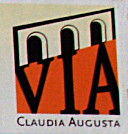


This route is a part of an ambitious European planned route called “Via Claudia Augusta” which starts from Augsburg in Bavaria and goes all the way to Venice or to Verona; the route is well signed predominantly with arrows incorporating the logo shown on the right.
Point of departure is the train station at Feltre, a historic town in the province of Belluno. Upon leaving the station take the road to the left [Viale del Grappa and then Via Monte Tomatico to the right] and head up to the street that runs below the city walls of the historic center [Via Campo Giorgio]. [It is essential that you consult Paolo’s map to understand all of the turns and street names on this route. RB] If you wish you can go nel centro [into town]; a steep climb takes you to the Piazza Maggiore [main piazza] where you will find the town hall, the municipal theater and monuments to Vittorino da Feltre and Panfilo Castaldi, the two most celebrated sons of this town.
Once you have looped around the historic part of the city you will come up to the statale [state road SS50] at a rotary. Proceed through the rotary and continue for about 700 m (.4 mile) and then take the road to the left [Via Monsignore Catarossi], signed with the Via Claudia Augusta logo; it first runs through a neighborhood of Feltre and then continues to the settlement of Mugnai; after this you ride briefly along the statale but immediately after take the road to the right towards Fonzaso. Here you will find a road to the left (always indicated with the logo) towards Frassenè and after having once again crossed the statale you come to a very peaceful descending road that takes you as far the Lago [lake] di Corlo and the village of Arsiè.
A gentle uphill stretch takes you into the village of Arsiè, dominated by the imposing edifice of the town hall, then you continue in a gentle descent as far as the village of Fastro where the “dive” into Primolano starts on a road with many hairpin curves (the Primolano staircase), dominated by a fortress constructed by the Italian army at the end of the nineteenth century to control the gorge below, which would be an essential route to attack the Veneto if coming from Valsugana, which then was part of the Austrian Empire. This descent is known also for being the location of the disastrous fall, on June 2, 1950, of Italian biking hero, Fausto Coppi, who was hit by another biker during the Vicenza-Bolzano section of the Giro d’Italia, in which he fractured his pelvis and had to interrupt his racing career for many months.
At the end of the descent you arrive in the center of the village of Primolano, where you turn left, continue across the bridge over the railroad tracks and the statale, and finally arrive at a broad open space where we come to the junction with the Ciclopista del Brenta.
Taking the bike route at the far side of the open space to the right, you continue to Tezze and then as far as Borgo Valsugana, where this route ends, but of course you can go further as far as the lake at Calceranica and Trento.